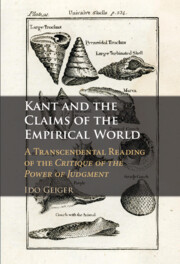 Kant and the Claims of the Empirical World
Kant and the Claims of the Empirical World Book contents
- Kant and the Claims of the Empirical World
- Kant and the Claims of the Empirical World
- Copyright page
- Dedication
- Epigraph
- Contents
- Acknowledgments
- Abbreviations
- Introduction
- Chapter 1 The Charge of Reflective Judgment and the Conceptual and Aesthetic Purposiveness of Nature
- Chapter 2 Organisms, Teleological Judgment and the Methodology of Biology
- Chapter 3 The Antinomy of Teleological Judgment
- Chapter 4 Discursivity and the Conceptual Purposiveness of Nature
- Chapter 5 The Significance of Form and the Aesthetic Purposiveness of Nature
- Conclusion: Kant’s Empiricism
- References
- Index
- References
References
Published online by Cambridge University Press: 30 April 2022
- Kant and the Claims of the Empirical World
- Kant and the Claims of the Empirical World
- Copyright page
- Dedication
- Epigraph
- Contents
- Acknowledgments
- Abbreviations
- Introduction
- Chapter 1 The Charge of Reflective Judgment and the Conceptual and Aesthetic Purposiveness of Nature
- Chapter 2 Organisms, Teleological Judgment and the Methodology of Biology
- Chapter 3 The Antinomy of Teleological Judgment
- Chapter 4 Discursivity and the Conceptual Purposiveness of Nature
- Chapter 5 The Significance of Form and the Aesthetic Purposiveness of Nature
- Conclusion: Kant’s Empiricism
- References
- Index
- References
Summary

- Type
- Chapter
- Information
- Kant and the Claims of the Empirical WorldA Transcendental Reading of the <I>Critique of the Power of Judgment</I>, pp. 216 - 222Publisher: Cambridge University PressPrint publication year: 2022


